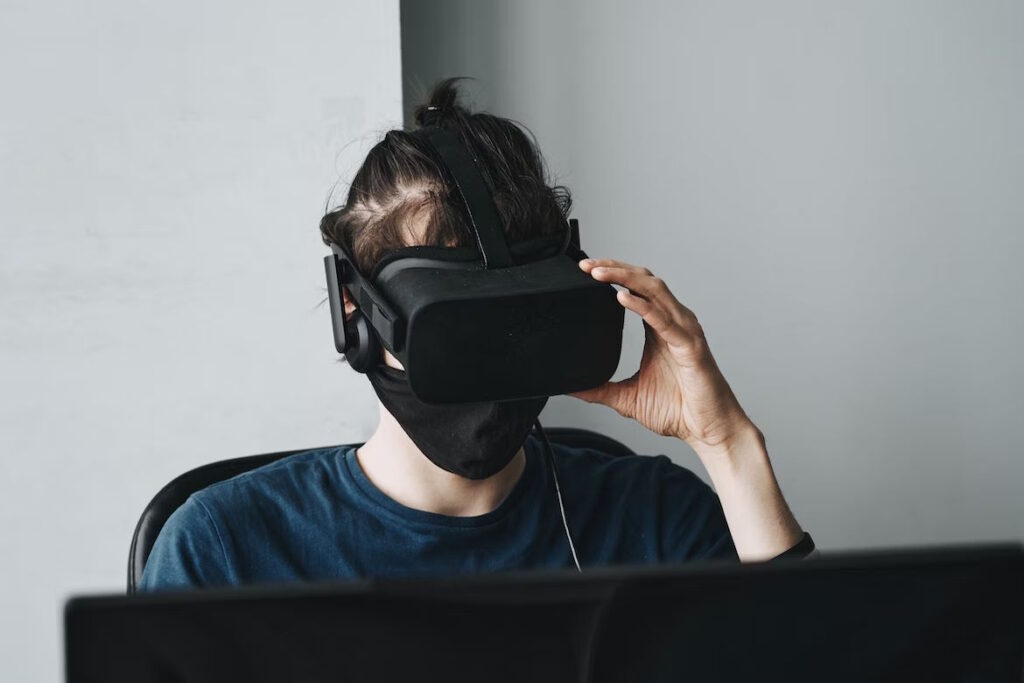In recent years, extended reality (XR)—which encompasses virtual reality (VR), augmented reality (AR), and mixed reality (MR)—has begun to permeate various industries, including manufacturing and automation. Together with robotics, these immersive technologies are driving unprecedented changes, transforming the way processes are executed and enhancing human-machine interactions. This article aims to explore the pioneering advancements of VR in manufacturing and automation, highlighting its potential to revolutionize the industry.
Training and Simulation in Virtual Reality
Virtual Reality (VR) is transforming training and simulation in manufacturing and automation. VR creates a highly realistic, immersive environment that mirrors real-world conditions. This offers businesses in all industries an innovative solution for training scenarios.
Trainees can interact with virtual equipment, machinery, and systems, acquiring the necessary skills without the risk of causing costly errors or accidents. This makes VR an exceptional learning tool, helping to foster a culture of safety in the workplace.
VR training eliminates the need for physical prototypes, further reducing costs and saving valuable resources. Workers can learn to operate complex machinery, perform intricate tasks, and even navigate crisis situations in a risk-free environment. A study published on MDPI exemplifies the efficacy of VR in these situations, demonstrating how it reduces the learning curve while improving retention rates.
Design and Prototyping with XR Technologies
XR technologies are proving invaluable in the design and prototyping phase of manufacturing. Virtual prototyping, facilitated by VR and AR, allows engineers and designers to visualize, interact with, and test their designs before moving to production.
The ability to identify potential design flaws early in the process reduces the likelihood of costly errors during production, thus increasing overall cost efficiency. Furthermore, these technologies enable design and production teams to collaborate more effectively, leading to optimized production processes.
A 2021 study illustrates the potential of VR in identifying design flaws and optimizing production processes, underscoring its indispensable role in modern manufacturing.
Remote Collaboration and Assistance
The integration of XR and robotics facilitates real-time collaboration between remote teams, breaking down geographical barriers and fostering a more cohesive and efficient workflow. For instance, AR can provide visual guidance to operators in manufacturing environments, even when the expert is located thousands of miles away. Similarly, educational institutions can use 3D university tours to allow prospective students to explore campuses virtually from any location.
AR-assisted remote troubleshooting significantly reduces equipment downtime, enhancing overall productivity. This is particularly useful in complex or high-risk environments where expert assistance is necessary but may not be immediately available. In such scenarios, AR allows experts to guide on-site personnel through intricate procedures safely and efficiently.
Enhancing Human-Robot Interaction
In modern manufacturing environments, robots perform a variety of tasks, from assembly to inspection, often working side by side with humans. XR technologies are critical to enhancing these human-robot interactions, facilitating more efficient and harmonious operations.
For instance, operators can use VR interfaces to remotely control robotic systems. This capability allows for precise, effortless coordination, reducing the likelihood of errors and accidents. It also paves the way for the operation of robots in potentially hazardous environments, keeping human workers safe.
Maintenance and Troubleshooting with XR
XR technologies are significantly enhancing maintenance and troubleshooting operations within manufacturing. Technicians can use AR overlays to visualize the internal workings of complex systems, enabling them to identify and resolve issues more quickly and effectively.
This technology can be particularly useful for training maintenance personnel, allowing them to practice procedures in a virtual environment before performing them on actual equipment. The result is reduced downtime, extended equipment life, and significant cost savings. Real-time AR assistance can also provide step-by-step guidance during actual maintenance and repair operations, further increasing efficiency and reducing the risk of errors.
Implications and Future Trends
The impact of XR and robotics on manufacturing and automation is profound. These technologies are streamlining operations, improving safety, and increasing efficiency, ushering in a new era for the industry. For example, they can aid organizations looking to get ISO certified by enhancing precision and consistency in their processes.
However, the adoption of these technologies is not without challenges. Significant investment in hardware, software, and training is required, and there’s a learning curve for workers unfamiliar with these advanced tools. Also, manufacturers must consider issues of cybersecurity, given the digital nature of these technologies.
Yet, these challenges are surmountable, and the benefits of XR and robotics far outweigh the initial hurdles. As these technologies continue to evolve and become more accessible, their adoption within the manufacturing industry is set to increase.
Emerging trends, such as the use of artificial intelligence (AI) to enhance XR experiences and the development of more sophisticated robotic systems, promise to further revolutionize manufacturing and automation. AI can analyze data from VR training simulations to provide personalized feedback, while advances in robotics are leading to more versatile and autonomous systems.
Moreover, these technologies play a role in broader societal goals, such as efforts to decarbonize the global energy supply. Robotics and XR can streamline energy-intensive processes and enable more efficient use of resources, contributing to the global sustainability agenda.
As we look ahead, the convergence of XR, robotics, AI, and other emerging technologies will continue to push the boundaries of what’s possible in manufacturing and automation.
Empower Your Projects with Interactiva Studios’ Cutting-Edge VR Solutions!
Are you ready to revolutionize your manufacturing processes with the power of Virtual Reality? Interactiva Studios is here to make that possible. Our team of seasoned experts is ready to guide you on your journey to automation, leveraging immersive VR technology to elevate your operations to unprecedented heights.
From crafting realistic training simulations to facilitating remote collaboration, our VR solutions can transform every facet of your projects. Contact us to get started!



